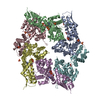+ Open data
Open data
- Basic information
Basic information
| Entry | Database: EMDB / ID: EMD-21195 | ||||||||||||
|---|---|---|---|---|---|---|---|---|---|---|---|---|---|
| Title | ClpXP from N. meningitidis- D7 symmetry applied | ||||||||||||
 Map data Map data | ClpXP complex from N. meningitidis, with D7 symmetry | ||||||||||||
 Sample Sample |
| ||||||||||||
| Biological species |  Neisseria meningitidis (bacteria) Neisseria meningitidis (bacteria) | ||||||||||||
| Method | single particle reconstruction / cryo EM / Resolution: 2.3 Å | ||||||||||||
 Authors Authors | Ripstein ZA / Vahidi S / Kay LE / Rubinstein JL | ||||||||||||
| Funding support |  Canada, 3 items Canada, 3 items
| ||||||||||||
 Citation Citation |  Journal: Elife / Year: 2020 Journal: Elife / Year: 2020Title: A processive rotary mechanism couples substrate unfolding and proteolysis in the ClpXP degradation machinery. Authors: Zev A Ripstein / Siavash Vahidi / Walid A Houry / John L Rubinstein / Lewis E Kay /  Abstract: The ClpXP degradation machine consists of a hexameric AAA+ unfoldase (ClpX) and a pair of heptameric serine protease rings (ClpP) that unfold, translocate, and subsequently degrade client proteins. ...The ClpXP degradation machine consists of a hexameric AAA+ unfoldase (ClpX) and a pair of heptameric serine protease rings (ClpP) that unfold, translocate, and subsequently degrade client proteins. ClpXP is an important target for drug development against infectious diseases. Although structures are available for isolated ClpX and ClpP rings, it remains unknown how symmetry mismatched ClpX and ClpP work in tandem for processive substrate translocation into the ClpP proteolytic chamber. Here, we present cryo-EM structures of the substrate-bound ClpXP complex from at 2.3 to 3.3 Å resolution. The structures allow development of a model in which the sequential hydrolysis of ATP is coupled to motions of ClpX loops that lead to directional substrate translocation and ClpX rotation relative to ClpP. Our data add to the growing body of evidence that AAA+ molecular machines generate translocating forces by a common mechanism. | ||||||||||||
| History |
|
- Structure visualization
Structure visualization
| Movie |
 Movie viewer Movie viewer |
|---|---|
| Structure viewer | EM map:  SurfView SurfView Molmil Molmil Jmol/JSmol Jmol/JSmol |
| Supplemental images |
- Downloads & links
Downloads & links
-EMDB archive
| Map data |  emd_21195.map.gz emd_21195.map.gz | 97 MB |  EMDB map data format EMDB map data format | |
|---|---|---|---|---|
| Header (meta data) |  emd-21195-v30.xml emd-21195-v30.xml emd-21195.xml emd-21195.xml | 13.9 KB 13.9 KB | Display Display |  EMDB header EMDB header |
| Images |  emd_21195.png emd_21195.png | 70.6 KB | ||
| Archive directory |  http://ftp.pdbj.org/pub/emdb/structures/EMD-21195 http://ftp.pdbj.org/pub/emdb/structures/EMD-21195 ftp://ftp.pdbj.org/pub/emdb/structures/EMD-21195 ftp://ftp.pdbj.org/pub/emdb/structures/EMD-21195 | HTTPS FTP |
-Validation report
| Summary document |  emd_21195_validation.pdf.gz emd_21195_validation.pdf.gz | 78.1 KB | Display |  EMDB validaton report EMDB validaton report |
|---|---|---|---|---|
| Full document |  emd_21195_full_validation.pdf.gz emd_21195_full_validation.pdf.gz | 77.2 KB | Display | |
| Data in XML |  emd_21195_validation.xml.gz emd_21195_validation.xml.gz | 493 B | Display | |
| Arichive directory |  https://ftp.pdbj.org/pub/emdb/validation_reports/EMD-21195 https://ftp.pdbj.org/pub/emdb/validation_reports/EMD-21195 ftp://ftp.pdbj.org/pub/emdb/validation_reports/EMD-21195 ftp://ftp.pdbj.org/pub/emdb/validation_reports/EMD-21195 | HTTPS FTP |
-Related structure data
- Links
Links
| EMDB pages |  EMDB (EBI/PDBe) / EMDB (EBI/PDBe) /  EMDataResource EMDataResource |
|---|
- Map
Map
| File |  Download / File: emd_21195.map.gz / Format: CCP4 / Size: 103 MB / Type: IMAGE STORED AS FLOATING POINT NUMBER (4 BYTES) Download / File: emd_21195.map.gz / Format: CCP4 / Size: 103 MB / Type: IMAGE STORED AS FLOATING POINT NUMBER (4 BYTES) | ||||||||||||||||||||||||||||||||||||||||||||||||||||||||||||
|---|---|---|---|---|---|---|---|---|---|---|---|---|---|---|---|---|---|---|---|---|---|---|---|---|---|---|---|---|---|---|---|---|---|---|---|---|---|---|---|---|---|---|---|---|---|---|---|---|---|---|---|---|---|---|---|---|---|---|---|---|---|
| Annotation | ClpXP complex from N. meningitidis, with D7 symmetry | ||||||||||||||||||||||||||||||||||||||||||||||||||||||||||||
| Projections & slices | Image control
Images are generated by Spider. | ||||||||||||||||||||||||||||||||||||||||||||||||||||||||||||
| Voxel size | X=Y=Z: 1.06 Å | ||||||||||||||||||||||||||||||||||||||||||||||||||||||||||||
| Density |
| ||||||||||||||||||||||||||||||||||||||||||||||||||||||||||||
| Symmetry | Space group: 1 | ||||||||||||||||||||||||||||||||||||||||||||||||||||||||||||
| Details | EMDB XML:
CCP4 map header:
| ||||||||||||||||||||||||||||||||||||||||||||||||||||||||||||
-Supplemental data
- Sample components
Sample components
-Entire : ClpXP complex
| Entire | Name: ClpXP complex |
|---|---|
| Components |
|
-Supramolecule #1: ClpXP complex
| Supramolecule | Name: ClpXP complex / type: complex / ID: 1 / Parent: 0 Details: Complex formed between ClpX hexmers and a ClpP tetradecamer |
|---|---|
| Source (natural) | Organism:  Neisseria meningitidis (bacteria) Neisseria meningitidis (bacteria) |
| Recombinant expression | Organism:  |
| Molecular weight | Theoretical: 860 KDa |
-Experimental details
-Structure determination
| Method | cryo EM |
|---|---|
 Processing Processing | single particle reconstruction |
| Aggregation state | particle |
- Sample preparation
Sample preparation
| Concentration | 2 mg/mL | ||||||||||
|---|---|---|---|---|---|---|---|---|---|---|---|
| Buffer | pH: 8.5 Component:
Details: Buffer pH was measured as 8.2 at room temperature corresponding to a pH of 8.5 at 4 degrees, the temperature at which the complex was held before vitrification | ||||||||||
| Grid | Support film - topology: HOLEY / Support film - Film thickness: 30.0 nm / Details: unspecified | ||||||||||
| Vitrification | Cryogen name: ETHANE-PROPANE / Chamber humidity: 100 % / Chamber temperature: 277 K / Instrument: FEI VITROBOT MARK III / Details: Blotted for 15 seconds at an offset of -5 mm. | ||||||||||
| Details | Mono-disperse complexes |
- Electron microscopy
Electron microscopy
| Microscope | TFS KRIOS |
|---|---|
| Temperature | Min: 70.0 K / Max: 77.0 K |
| Image recording | Film or detector model: FEI FALCON III (4k x 4k) / Detector mode: COUNTING / Digitization - Dimensions - Width: 4096 pixel / Digitization - Dimensions - Height: 4096 pixel / Number grids imaged: 1 / Number real images: 2680 / Average exposure time: 60.0 sec. / Average electron dose: 43.0 e/Å2 |
| Electron beam | Acceleration voltage: 300 kV / Electron source:  FIELD EMISSION GUN FIELD EMISSION GUN |
| Electron optics | C2 aperture diameter: 50.0 µm / Illumination mode: FLOOD BEAM / Imaging mode: BRIGHT FIELD / Cs: 2.7 mm / Nominal defocus max: 1.7 µm / Nominal defocus min: 0.9 µm / Nominal magnification: 75000 |
| Sample stage | Specimen holder model: FEI TITAN KRIOS AUTOGRID HOLDER / Cooling holder cryogen: NITROGEN |
| Experimental equipment |  Model: Titan Krios / Image courtesy: FEI Company |
+ Image processing
Image processing
-Atomic model buiding 1
| Initial model | PDB ID: |
|---|---|
| Refinement | Space: REAL / Protocol: RIGID BODY FIT |
 Movie
Movie Controller
Controller









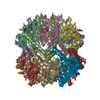
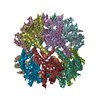
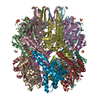

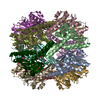


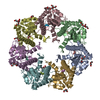
 Z (Sec.)
Z (Sec.) Y (Row.)
Y (Row.) X (Col.)
X (Col.)





















